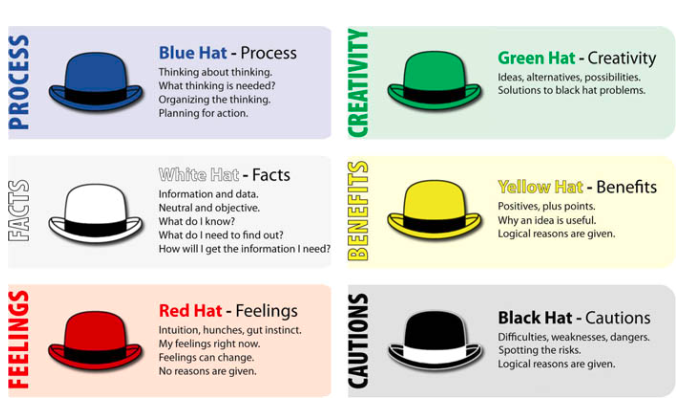It’s a hard truth in business: Everyone loves progress, but no one really likes change.
Whenever there’s a significant process change in a company, people get unsettled. Some spend more time worrying than working; others turn into negative loudspeakers, breathing loud complaints to demoralise their peers.
And now you’re in the hot seat – tasked to lead the new enterprise resource planning (ERP) system project for your organisation.
To run this successfully, you need more than just the right functional mix of people in your ERP project team.
You’ll need control over your team’s discussions to prevent the very real problem of groupthink.
Groupthink happens often during times of change and uncertainty. To avoid conflict and/or challenging ideas, people tend to compromise on what’s important in favour of what usually is a poorly thought-out group consensus.
Mastering Change Discussions: The Six Thinking Hats Technique
The Six Thinking Hats in sum. Source: Request Reduce
Business consultant Edward de Bono developed a process that attempts to address that problem: The Six Thinking Hats technique.
Think of the method as a sort of role-play: a group of six or more people consider a problem through six different perspectives (represented by multicoloured hats - details after this section).
But instead of assigning a perspective to each person, the group collectively brainstorms, one perspective at a time.
For example, the group gathers the facts about a problem, before jointly tackling it with solutions. Everyone explores the upsides of these ideas – and then argues why they won’t work afterwards.
In a sense, everyone works through the standard thinking process as a team.
The point's to allow all these perspectives to come into play, without the tricky balancing act of juggling them all at the same time – or giving too much weight to one perspective
“The main difficulty of thinking is confusion. We try to do too much at once. Emotions, information, logic, hope and creativity all crowd in on us. It is like juggling with too many balls,” writes de Bono.
With these general principles in mind, let’s drill down into the hats, and how you might apply the process to your ERP project discussions.
Applying the Six Thinking Hats to your ERP Project
The Blue Hat: Manages the Discussion

Blue Hats aren't involved in the discussion of ideas per se. Instead, think of the Blue Hat as a Discussion Moderator: with Blue Hats on, you and your team will set the agenda and manage the thinking process.
A Blue Hat perspective works best when kicking off meetings and drawing conclusions, and so for that reason it’s best used by the chair of the meeting.
That said, anyone can take on that role in trying to shift things back to the big picture, or when someone deviates from the flow:
“From a Blue Hat perspective, you sound like you’re tackling it from a Black Hat perspective instead of the Green Hats we’re all wearing.”
The White Hat: Factual View

Facts, and facts alone: during a White Hat thinking session, pull out all the relevant numbers and nothing more.
“Now, what I want is, Facts. Facts alone are wanted in life,” goes the opening line to Charles Dickens's novel Hard Times.
The point isn't to be dogmatic about facts like the speaker of this infamous line is. Instead, you'll be focused on reporting the facts as they are - no interpretations or value judgements allowed.
In a discussion about improving your reporting processes for example, in White Hat mode you and your team will present relevant metrics without making opinions about the data. Think establishing how long it takes to generate weekly cash flow reports. Any reactions to the actual length of the process should come under the purview of the Red Hat (see below).
The Green Hat: Creative Solutions

When you put on a Green Hat, it’s time to get creative with solutions in response to the facts.
Thinking in a Green Hat capacity, you might debate ways of improving reporting and visibility into your organisation – customised reports vs a reporting add-on. Or you might realise that your company needs analytics as well – so you turn to a business intelligence solution instead.
The Red Hat: Emotional View

When thinking with a Red Hat on, voice your gut instincts: how does the solution make you feel? No whys needed.
A Red Hat mindset bridges the gap left by White Hat: it’s where gut feelings, intuition, and emotions come into play – no qualifications or justifications allowed.
With Red Hats on, you'll sift out emotional biases that might crop up during the thinking process. More than that, it can help unearth problems behind the facts gathered with a White Hat analysis.
For instance, your finance colleagues need two days to produce a weekly cash flow report, a Red Hat perspective might conclude that the process is taking too long.
Thinking from a Red Hat perspective can also pave the way for more dispassionate analyses of potential conflicts. If you’ve an uneasy gut feeling about an ERP vendor you’re considering working with, this can be a signal to probe deeper with further White Hat thinking.
The Yellow Hat: Optimistic View

A Yellow Hat perspective gets you to consider the upside of every idea – even the most outrageous ones.
Throughout the project, it’ll also help to have someone with a Yellow Hat personality (as opposed to a perspective) as a project cheerleader. Someone who might point out how an ERP system can help reduce tedious paperwork, for example, and help get employee buy-in.
The Black Hat: Cautious, Negative View

A Black Hat perspective will enable a cautious, even pessimistic outlook. Where you might champion an idea while wearing a Yellow Hat, with a Black Hat on you’ll be arguing why the same idea will fail instead.
Used judiciously, a Black Hat perspective can challenge your team to think from a people and processes perspective – instead of focusing on the technical aspects.
They can also be used to uncover flaws in the thinking process. If your discussions are giving too much weight to Red Hat gut feelings about vendors, wearing a Black Hat might reveal that.
Thought sessions with Black Hats work well when evaluating the success of your ERP implementation a year later, for example. Pointing out where a new inefficiency has cropped up – think spreadsheets as a workaround – might help tease out issues when ground sentiment is mostly neutral.
Put on Your Thinking Hats for A Successful ERP Implementation
What we’ve covered here is really a cursory overview of a concept that’s gotten full book treatment – so we’d encourage you to read it to get a better idea of how you can put it into action.
In sum, thanks to the Six Thinking Hats technique, even negative mindsets can be harnessed for the greater good. With input from important perspectives like these and more, you can rest assured that you’re making sound decisions.

.png)



